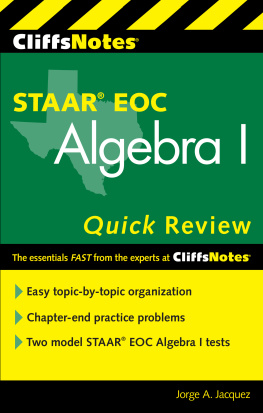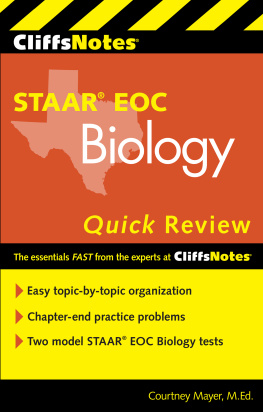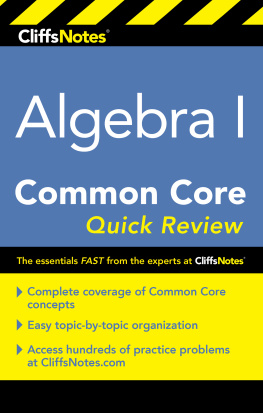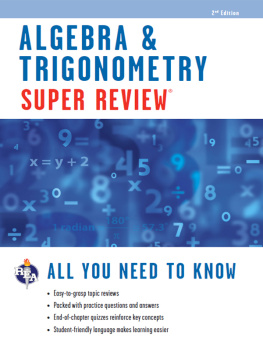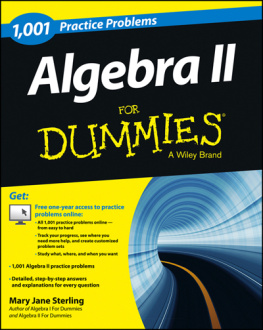Table of Contents
About the Author Jorge A. Jacquez is an acclaimed educator and curriculum writer in the state of Texas. Each year, Mr. Jacquez lectures at local and nationally recognized conferences on best teacher practices and modern techniques for nurturing algebraic reasoning. He began his professional teaching career in his hometown of El Paso, Texas, and is currently an Algebra I, Geometry, and Precalculus teacher in Austin, Texas. Editorial Executive Editor: Greg Tubach Senior Editor: Christina Stambaugh Copy Editor: Lynn Northrup Technical Editors: Mary Jane Sterling and Tom Page Proofreader: Donna Wright |
CliffsNotes STAAR EOC Algebra I Quick Review
Copyright 2016 by Houghton Mifflin Harcourt Publishing Company
All rights reserved.
Library of Congress Control Number: 2015943211
ISBN: 978-0-544-51917-6 (pbk)
eISBN: 978-0-544-51983-1
v1.1015
For information about permission to reproduce selections from this book, write to Permissions, Houghton Mifflin Harcourt Publishing Company, 215 Park Avenue South, New York, New York 10003.
www.hmhco.com
The publisher and the author make no representations or warranties with respect to the accuracy or completeness of the contents of this work and specifically disclaim all warranties, including without limitation warranties of fitness for a particular purpose. No warranty may be created or extended by sales or promotional materials. The advice and strategies contained herein may not be suitable for every situation. This work is sold with the understanding that the publisher is not engaged in rendering legal, accounting, or other professional services. If professional assistance is required, the services of a competent professional person should be sought. Neither the publisher nor the author shall be liable for damages arising herefrom. The fact that an organization or Website is referred to in this work as a citation and/or a potential source of further information does not mean that the author or the publisher endorses the information the organization or Website may provide or recommendations it may make. Further, readers should be aware that Internet Websites listed in this work may have changed or disappeared between when this work was written and when it is read.
Trademarks: CliffsNotes, the CliffsNotes logo, Cliffs, CliffsAP, CliffsComplete, CliffsQuickReview, CliffsStudySolver, CliffsTestPrep, CliffsNote-a-Day, cliffsnotes.com, and all related trademarks, logos, and trade dress are trademarks or registered trademarks of Houghton Mifflin Harcourt and/or its affiliates. STAAR is a registered trademark of the Texas Education Agency, which does not sponsor or endorse this product. All other trademarks are the property of their respective owners. Houghton Mifflin Harcourt is not associated with any product or vendor mentioned in this book.
INTRODUCTION
C liffsNotes STAAR EOC Algebra I Quick Review is a reference tool that will help you review the important elements of Algebra I necessary to master the STAAR End of Course (EOC) Exam.
What Is STAAR End of Course?
STAAR stands for State of Texas Assessments of Academic Readiness, and EOC stands for end of course. Texas high school students must meet a Satisfactory Academic Performance (Level II) on each EOC assessment they take in order to graduate.
Students will be tested in five reporting categories. These are listed below, along with the corresponding chapters in this book:
Number and Algebraic Methods ()
Describing and Graphing Linear Functions, Equations, and Inequalities ()
Writing and Solving Linear Functions, Equations, and Inequalities ()
Quadratic Functions and Equations ()
Exponential Functions and Equations ()
Important Facts About the STAAR EOC Algebra I Exam
The exam consists of 54 multiple-choice questions.
Students will have 4 hours to complete the STAAR EOC Algebra I Exam. Students are allowed to take breaks to get a drink of water, have a snack, or use the restroom, but the test clock will not pause for these breaks. Practice timing yourself while taking the two full-length practice tests in to prepare for the timed setting of the actual exam.
Students will have access to a handheld, four-function, scientific, or graphing calculator. There will be at least one calculator for every five students on the day of the test. If a calculator is used by multiple students, its memory must be cleared after each use.
Your STAAR EOC Algebra I test booklet contains reference materials, including a formula chart and graph paper. On , weve provided a formula chart similar to the one that will be in your test booklet. Familiarize yourself with these formulas.
The test may be administered as a paper-and-pencil exam or on a computer. The test administration method varies by school and by school district. Some school districts administer this exam toward the end of the school year. The results of this exam are sometimes used to award credit for an Algebra I course.
For additional information on the STAAR EOC Algebra I Exam, visit http://tea.texas.gov/student.assessment/staar/math/.
How to Use This Book
Suggested approaches
There are a number of ways you can use this book to prepare for the STAAR EOC Algebra I Exam. You decide what works best for your needs. Here are a few suggested approaches:
Tech tips
In several chapters in this book, weve provided Tech Tips to show you how to use a calculator to solve certain types of problems. Practice using your calculator where appropriate to check your solutions and as a time-saver.
Chapter 1
FOUNDATIONS FOR ALGEBRA
Chapter Check-In
B efore we dive into the basic elements of algebra, lets first discuss some of its essential building blocks. In order to use algebra to solve real-world problems, you must be able to understand its fundamental rules. We will also explore the language of algebra, which will allow us to switch back and forth between algebra and words.
Working with Numbers
A variable is an unknown numerical value, usually represented by a symbol or a letter of the alphabet.
A constant is a number that does not change and has no variable.
A mathematical operation is an action or a process that will sometimes result in a new value. The four main mathematical operations are addition, subtraction, multiplication, and division. These mathematical operations can also be represented by symbols. They are:

